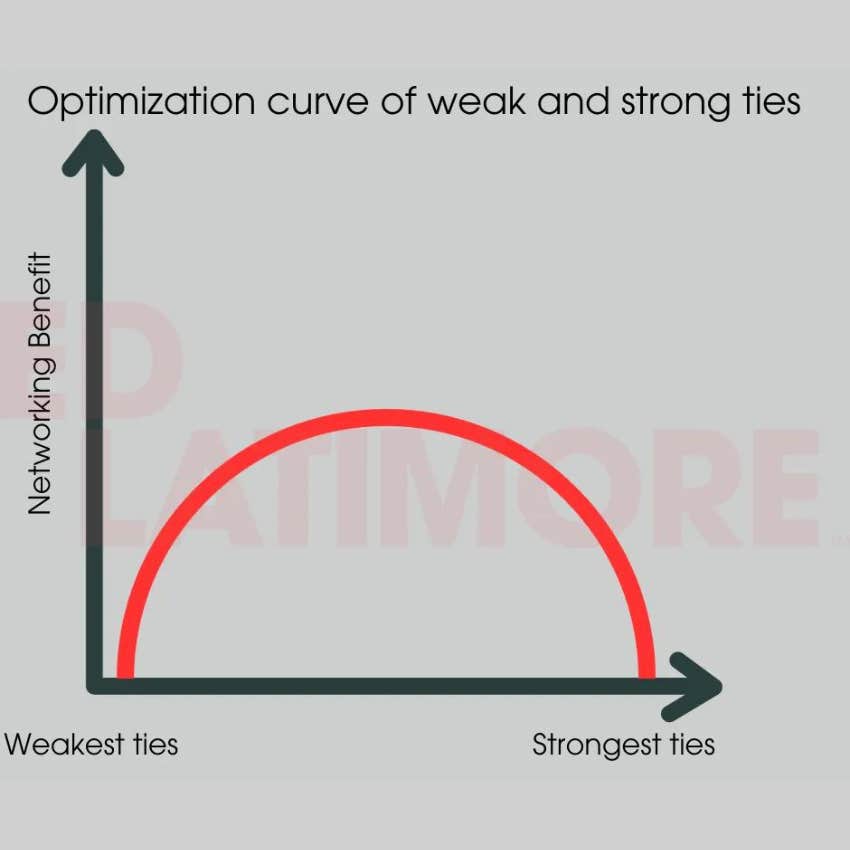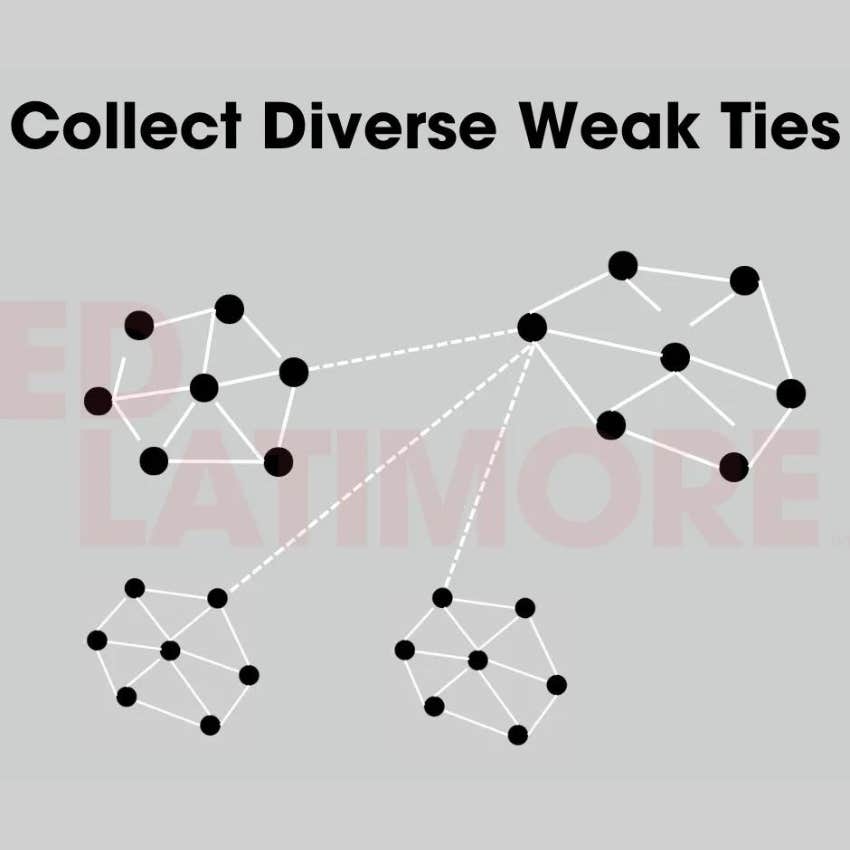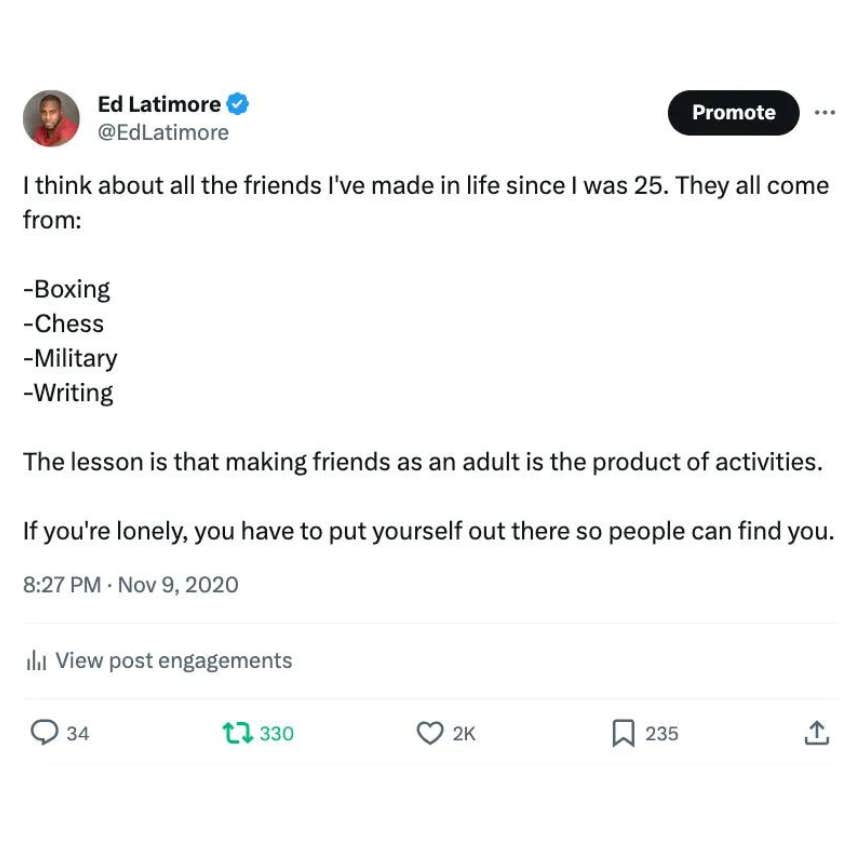Making This Tiny Change In How You Use Social Networks Will Make You 98% More Successful Than Your Peers
The old saying goes, “It’s not what you know, but who.” The idea is that personal connections are more responsible for professional success than merit or ability. It’s certainly observable in cases of nepotism or cronyism, but those are so obvious that they don’t teach us anything useful or that we didn’t already know.
We need something faster and more specific — an effective approach to leveraging our connections that’s fresh. Ideally, the solution won’t feel like the traditional networking that so many people dread almost as much as they hate the idea of selling.
The answer — the theory of weak ties — is here to save the day, and baked into the solution is an easy method to increase your chances of finding work, clients, friends, and romance.
What is the theory of weak ties?
The counterintuitive theory states that people in our social networks with whom we are only peripherally acquainted can actually have a greater impact on our success in various areas than our closer friends can have.
In 1973, Stanford sociologist Mark Granovetter developed the theory in his influential work, “The Strength of Weak Ties.” He referred to close, intimate relationships as strong ties, while more distant connections were labelled weak ties.
Our strong ties are our close friendships and family bonds.
These relationships provide emotional support, a sense of belonging, and the ability to mobilize aid in distress. Strong ties are built through shared life experiences over long periods of time, leading to trust and reciprocity. We interact frequently with these strong-tie connections, relying on each other for both affection and assistance.
On the other hand, weak ties represent our broader social network of acquaintances.
These include old classmates we rarely talk to, distant relatives we see only occasionally, or colleagues from an old job. The interactions are more limited and often situational. But most importantly, these weak ties bridge different social circles, giving access to non-redundant sources of information and opportunities for collaboration.
They expose us to fresh ideas and diverse world views. While our inner circle of confidants provides intimacy, the outer layer of weaker ties gives flexibility.
Through weak ties, we can tap into the resources, knowledge, and perspectives of a more comprehensive array of people.
It is the combination of strong ties that bond and weak ties that bridge, which enables cooperation and innovation on a societal level. Our networks gain strength and vitality when weak ties between groups are woven together.
Strong Ties
- Very close, intimate relationships (e.g., family members, close friends)
- People you interact with frequently and are strongly connected to
- Built on trust, reciprocity, and shared experiences over a long time
- Provide emotional support and the ability to mobilize aid
Weak Ties
- More casual social acquaintances and connections
- People you may know somewhat well but are not extremely close with
- Interact less frequently (e.g., old classmates, work colleagues)
- Usually more short-term or situational relationships
- Connect you to people and information outside your most immediate circle
A 2022 social media experiment proved the power of weak ties.
By conducting experiments with 20 million LinkedIn users over five years, an MIT research team confirmed Granovetter’s weak tie theory, showing that weaker social connections are more likely to expose people to new job opportunities and spur greater job mobility than one’s closest contacts.
Specifically, they found that moderate to weak tie strength led to the highest job mobility rates, according to the data on 600,000 new jobs generated. The weakest and strongest ties were associated with lower mobility rates, indicating an inverted U-shaped relationship between tie strength and mobility.

“When we look at the experimental data, weak ties are better, on average, for job mobility than strong ties,” says Sinan Aral, a management professor at MIT and co-author of a paper detailing the results of the study.
This relationship makes sense for the weakest of your weak ties. If you barely know someone or hardly ever talk to them, then it’s no different than not knowing them. They can’t pass you any new information or opportunities because they don’t pass you anything. You don’t talk!
But what about the strongest ties?
This revelation feels counterintuitive to the point of being incorrect, but the answer can be found in redundancy.
Let’s say you work with your identical twin brother. Not only do you work together, but you also socialize together, go to all the same events, and have all the same friends. You’re inseparable.
A relationship of this type is about as strong of a tie as you can have. It’s fantastic, but the downside is that any information he gets, you’ll also get.
You’ll know all the same people and see all the same job opportunities. Even worse, you become competitors because you have the same skill set and appearance. Not outwardly with hostility, but many aspects of your relationship will function as a zero-sum game.
Not only can you guys not help each other with new information (because you both get the same information), but you are both disincentivized from revealing any new information to the other.
At best, the relationship is unproductively homogenous. At worst, it is subtly competitive. The similarities of the individuals nullify the strong tie’s strength.
This thought exercise was explained in extremes to demonstrate the general idea.
After a certain point, the stronger your ties with someone, the less that person can provide you with new opportunities and information, and the more likely you’ll be competing for the same new resources.
How To Put The Theory Of Weak Ties To Work For You
1. Collect many diverse weak ties.
It’s essential to be clear that the status of a tie is not binary. Instead, it exists along a gradient. You have two goals: Collect diverse weak ties; and foster the most promising ones to the optimal level of strength.
People like that it’s the quality of your friends that matters—not the quantity. Generally speaking, this is good advice; you will avoid much suffering if you live by it. With that said, it’s a half-truth.
You want friends with different backgrounds, perspectives, and experiences. Aside from the benefit this has on sharpening your thinking process and keeping you out of an echo chamber, this diversity greatly helps you find out new things you don’t know that can help you.

I’ve seen people I grew up with complaining on social media about how small our city is. They usually say this whenever they try to date someone, and inevitably find out that this person dated someone in their social circle.
For reference, I grew up in Pittsburgh, PA. As of this writing, there are a little less than 330,000 people in the greater area and a little over 1 million in the metropolitan area. While these numbers don’t even place it in the top 50 most populated American cities, there is no reason you shouldn’t be able to meet someone who has never met someone in your social circle.
Unless you haven’t made it a point to meet different people.
2. Be intentional about meeting new people in new ways.
Meeting different people and making new friends is a whole post by itself, but the primary method I’ve followed is:
- Learn a new skill, take up a new hobby, or join a new group devoted to an interest I have.
- Feel out the people in the group for people who naturally align with my personality
- Start developing that friendship outside of the group
I wrote a tweet about this a while back that demonstrates this idea.
 All photos courtesy of the author.
All photos courtesy of the author.
While the goal is to diversify your friendships (which is often the exact opposite of how the average person makes friends), you need to have something in common to spark the initial connection.
That’s where this skill comes in. The rest is just social calibration.
3. Foster the most promising ties to the optimal level of strength.
Your time, energy, and attention are finite. In an ideal world, you have unlimited amounts of these things to create and build connections. The reality is that everything is a trade-off. In this case, you must trade between building new connections, nurturing old ones, and handling your responsibilities.
Shifting your time between these priorities means that most people won’t get the attention to be in your network, either as a weak or strong tie. And, of the people who are your weak ties, most of them won’t become strong. That’s alright.
The goal isn’t to make the tie as strong as possible. It’s to make it optimally strong.
And what is the optimal level of strength for a new connection?
- Can you call this person up and meet for a cup of coffee?
- Do you know them well enough to introduce them to your other ties?
Remember: relationships go both ways, so they should feel the same way about you. If you don’t have this familiarity with someone, they will likely not think of you when passing along unsolicited opportunities.
The good news is that social media makes it easier to get to and maintain this level of connection.
Technological convenience doesn’t mean that social media is a substitute for in-person connections, but think of it this way: for better or worse, 40-year-olds today have a much greater awareness of what their high school classmates have been up to since graduation than they ever did before.
There’s not even a reason for the traditional high school reunion anymore.
Building Business And Finding Romance With Weak Ties
When searching for either of those things, the ideas still hold because this is a fundamental law of human relationships, and humans are in every business deal and relationship.
If you don’t have a diverse, optimally strong group of network ties, you’ll never know anyone who doesn’t already know what you do. As a result, you’ll never get access to new opportunities and connections.
Instead, you’ll spend your life stuck after you’ve maxed your raw ability and connections with everyone you’ve always known.



